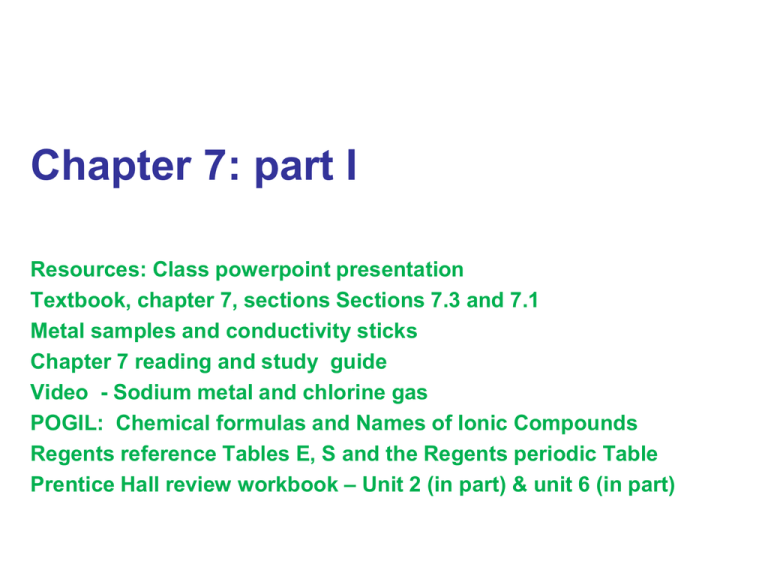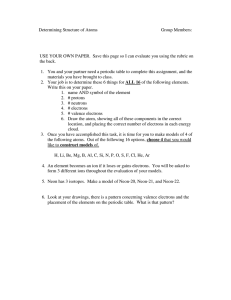
Ch. 7 presentation - part I
Chapter 7: part I
Resources: Class powerpoint presentation
Textbook, chapter 7, sections Sections 7.3 and 7.1
Metal samples and conductivity sticks
Chapter 7 reading and study guide
Video - Sodium metal and chlorine gas
POGIL: Chemical formulas and Names of Ionic Compounds
Regents reference Tables E, S and the Regents periodic Table
Prentice Hall review workbook – Unit 2 (in part) & unit 6 (in part)
7.3
Bonding in Metals > Metallic Bonds and Metallic Properties
Metallic Bonds and Metallic Properties
What are some of the properties of
metals? (review from chapter 6)
__________________________________
__________________________________
__________________________________
__________________________________
__________________________________
__________________________________
__________________________________
Slide
__________________________________2 of 19
© Copyright Pearson Prentice Hall
End Show
Bonding in Metals >
The valence electrons of metal atoms
can be modeled as a sea of
electrons.
Sea of electrons model
used to explain
bonding between metal
atoms; it is also useful
in explaining
characteristics of
metals (they conduct
electricity, are
maleable, are ductile,
etc.)
The model involves a positively
charged kernel (nucleus and
nonvalence electrons) and valence
electrons that are free to move or drift
freely from one part of the metal to
another. In this model the valence
electrons are mobile.
Metallic bonds consist of the
attraction of the free-floating valence
electrons for the positively charged
kernel of the metal atom
Slide
3 of 19
© Copyright Pearson Prentice Hall
End Show
7.3
Bonding in Metals > Metallic Bonds and Metallic Properties
Metals are ductile—that
is, they can be drawn into
wires.
Slide
4 of 19
© Copyright Pearson Prentice Hall
End Show
7.3
Bonding in Metals > Metallic Bonds and Metallic Properties
A force can change the shape of a metal. A force
can shatter an ionic crystal.
Slide
5 of 19
© Copyright Pearson Prentice Hall
End Show
7.3
Bonding in Metals > Crystalline Structure of Metals
Crystalline Structure of
Metals
How are metal
atoms arranged?
Metal atoms are arranged in
very compact and orderly
patterns.
Slide
6 of 19
© Copyright Pearson Prentice Hall
End Show
7.3
Bonding in Metals >
Alloys are mixtures
composed of two or more
elements, at least one of
which is a metal.
Alloys
Bicycle frames are often made of
titanium alloys that contain
aluminum and vanadium.
Alloys are important
because their
properties are often
superior to those of
their component
elements.
Slide
7 of 19
© Copyright Pearson Prentice Hall
End Show
7.3
Bonding in Metals > Alloys
The most important alloys
today are steels. Steels
have a wide range of useful
properties, such as
corrosion resistance,
ductility, hardness, and
toughness.
Slide
8 of 19
© Copyright Pearson Prentice Hall
End Show
7.3 Section Quiz.
Assess students’ understanding
of the concepts in Section 7.3.
Continue to:
-or-
Launch:
Section Quiz
Slide
9 of 19
© Copyright Pearson Prentice Hall
End Show
7.3 Section Quiz.
1. The valence electrons of metals can be
modeled as
a.
a body-centered cube.
b.
octets of electrons.
c.
a rigid array of electrons.
d.
a sea of electrons.
Slide
10 of 19
© Copyright Pearson Prentice Hall
End Show
7.3 Section Quiz.
2. In most metals, the atoms are
a. free to move from one part of the metal to
another.
b. arranged in a compact and orderly pattern.
c. placed at irregular locations.
d. randomly distributed.
Slide
11 of 19
© Copyright Pearson Prentice Hall
End Show
7.3 Section Quiz.
3. Alloys are important because they
a.
are pure substances.
b. are the ores from which metals can be
refined.
c. can have properties superior to those of
their components.
d. are produced by the combustion of metals.
Slide
12 of 19
© Copyright Pearson Prentice Hall
End Show
7.1
Valence Electrons and Chemical Properties
a. Valence electrons are the electrons in the
highest occupied energy level of an
element’s atoms.
b. The number of valence electrons largely
determines the chemical properties of an
element.
c. To find the number of valence electrons in
an atom of a representative element,
simply look at its group number and its
electron configuration (ref. Periodic Table).
Slide
13 of 19
© Copyright Pearson Prentice Hall
End Show
7.1
The Octet Rule
a. Noble gases, such as neon and argon, are
unreactive in chemical reactions. In 1916,
chemist Gilbert Lewis used this fact to
explain why atoms form certain kinds of
ions and molecules.
b. He called his explanation the octet rule: In
forming compounds, atoms tend to achieve
the electron configuration of a noble gas.
Slide
14 of 19
© Copyright Pearson Prentice Hall
End Show
7.1
The Octet Rule
The Octet Rule
Atoms of which elements tend to gain electrons?
Atoms of which elements tend to lose electrons?
Slide
15 of 19
© Copyright Pearson Prentice Hall
End Show
7.1
The Octet Rule
Atoms of metals tend to lose their valence
electrons, leaving a complete octet in the
next-lowest energy level. Atoms of some nonmetals tend to gain electrons or to share
electrons with another nonmetal to achieve a
complete octet.
Slide
16 of 19
© Copyright Pearson Prentice Hall
End Show
7.1
Formation of Cations
Formation of Cations
How are cations formed?
An atom’s loss of valence electrons produces a
cation, or a positively charged ion.
Slide
17 of 19
© Copyright Pearson Prentice Hall
End Show
Formation of Cations
7.1
a. The most common cations are those
produced by the loss of valence electrons
from metal atoms.
b. You can represent the electron loss, or
ionization, of the sodium atom by drawing
the complete electron configuration of the
atom and of the ion formed.
Slide
18 of 19
© Copyright Pearson Prentice Hall
End Show
Formation of Cations
7.1
a. The electron configuration of the sodium
ion is the same as that of a neon atom.
Slide
19 of 19
© Copyright Pearson Prentice Hall
End Show
Formation of Cations
7.1
a. Using electron dot structures, you can
show the ionization more simply.
Slide
20 of 19
© Copyright Pearson Prentice Hall
End Show
Formation of Cations
7.1
a. A magnesium atom attains the electron
configuration of neon by losing both
valence electrons. The loss of valence
electrons produces a magnesium cation
with a charge of 2+.
Slide
21 of 19
© Copyright Pearson Prentice Hall
End Show
Formation of Cations
7.1
a. Cations of Group 1
(alkali metals, 1A)
elements always
have a charge of
1+. Cations of
group 2 (alkaline
earth metals, 2A)
elements always
have a charge of
2+.
Slide
22 of 19
© Copyright Pearson Prentice Hall
End Show
Formation of Anions
7.1
Formation of Anions
How are anions formed?
The gain of negatively charged
electrons by a neutral atom
produces an anion.
a. An anion is an atom or a group of
atoms with a negative charge.
b. The name of an anion typically
ends in -ide.
Slide
23 of 19
© Copyright Pearson Prentice Hall
End Show
Formation of Anions
7.1
a. The figure
shows the
symbols of
anions formed
by some
elements in
Groups 15 (5A),
16 (6A), and 17
(7A).
Slide
24 of 19
© Copyright Pearson Prentice Hall
End Show
7.1
Formation of Anions
a. A gain of one electron gives chlorine an
octet and converts a chlorine atom into a
chloride ion. It has the same electron
configuration as the noble gas argon.
Slide
25 of 19
© Copyright Pearson Prentice Hall
End Show
Formation of Anions
7.1
a. Both a chloride ion and the argon atom
have an octet of electrons in their highest
occupied energy levels.
Slide
26 of 19
© Copyright Pearson Prentice Hall
End Show
Formation of Anions
7.1
a. In this equation, each dot in the electron
dot structure represents an electron in the
valence shell in the electron configuration
diagram.
Slide
27 of 19
© Copyright Pearson Prentice Hall
End Show
Formation of Anions
7.1
a. The negatively
charged ions in
seawater—the
anions—are
mostly chloride
ions.
Slide
28 of 19
© Copyright Pearson Prentice Hall
End Show
Formation of Anions
7.1
a. The ions that are produced when atoms of
chlorine and other halogens gain electrons
are called halide ions.
All halogen atoms have seven valence
electrons.
All halogen atoms need to gain only one
electron to achieve the electron
configuration of a noble gas.
Slide
29 of 19
© Copyright Pearson Prentice Hall
End Show
Formation of Anions
7.1
a. Oxygen is in Group 16 (6A).
Slide
30 of 19
© Copyright Pearson Prentice Hall
End Show
7.1
Conceptual Problem 7.1
Slide
31 of 19
© Copyright Pearson Prentice Hall
End Show
7.1
Conceptual Problem 7.1
Slide
32 of 19
© Copyright Pearson Prentice Hall
End Show
7.1
Conceptual Problem 7.1
Slide
33 of 19
© Copyright Pearson Prentice Hall
End Show
for Conceptual Problem 7.1
Slide
34 of 19
© Copyright Pearson Prentice Hall
End Show
7.1 Section Quiz.
7.1.
Slide
35 of 19
© Copyright Pearson Prentice Hall
End Show
7.1 Section Quiz.
1. How many valence electrons are there in an
atom of oxygen?
a. 2
b. 4
c. 6
d. 8
Slide
36 of 19
© Copyright Pearson Prentice Hall
End Show
7.1 Section Quiz.
2. Atoms that tend to gain a noble gas
configuration by losing valence electrons are
a. metals.
b. nonmetals.
c. noble gases.
d. representative elements.
Slide
37 of 19
© Copyright Pearson Prentice Hall
End Show
7.1 Section Quiz.
3. When a magnesium atom forms a cation, it
does so by
a. losing two electrons.
b. gaining two electrons.
c. losing one electron.
d. gaining one electron.
Slide
38 of 19
© Copyright Pearson Prentice Hall
End Show
END OF SHOW





